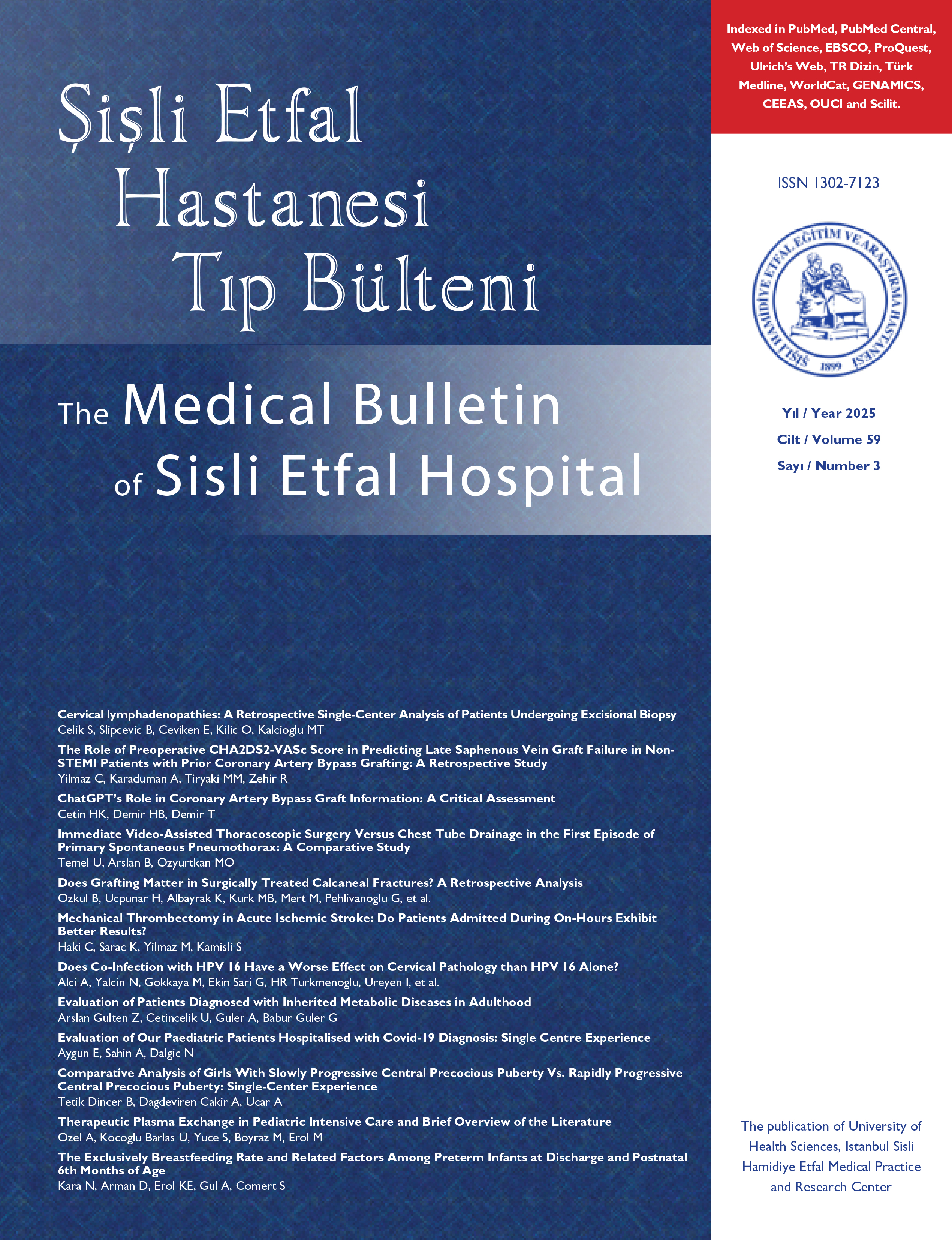
The relationship of hs-CRP with regulation of hypertension in patients who have both Type 2 diabetes mellitus and hypertension
Melek Başer1, Rahime Özgür2, Osman Maviş2, Ali Abbas Özdemir2, Ali Özkeskin3, Ömer Küçükdemirci2, Tayfun Elibol21Tarsus Devlet Hastanesi, İç Hastalıkları Kliniği, Mersin-Türkiye2Gaziosmanpaşa Taksim Eğitim ve Araştırma Hastanesi, İç Hastalıkları Kliniği, İstanbul-Türkiye
3Sandıklı Devlet Hastanesi, İç Hastalıkları Kliniği, Afyon-Türkiye
Objective: In different studies, it was determined that diabetes mellitus and hypertension can increase hs-CRP levels. In this study, we aim to compare the levels of hs-CRP between 2 groups with controlled or uncontrolled hypertension in patients who have both type 2 diabetes mellitus and hypertension.
Material and Method: We enrolled 64 female and 65 male, total 129 patient, into the study who admitted to our diabetes polyclinic between 2010 May and 2010 September. Patients sociodemographic properties, detailed histories, drug usage, anthropometric measures, physical examination findings and laboratuary results were investigated. Situations that affect CRP levels were excluded from the study. In this study, level of significance was considered to be p<0.05.
Results: In the study, 49.6% (n=64) of patients were female, and 50.4% (n=65) were male. Those who have regulated blood pressure was 65 (50.4%) and who have not regulated blood pressure was 64 (49.6%) people. Mean body mass index was 30.17±5.30 kg/m2. The mean duration of diabetes was 6.69±4.57 years, the mean duration of hypertension was 6.38±4.41 years. Those who have regulated hypertension, mean body mass index was 29.81±5.44, who have not regulated hypertension was 30.53±5.18. There was no statistically significant difference between the groups in terms of gender (p>0.05). There was no statistically significant difference between the groups in terms of HbA1c, total cholesterol, HDL- cholesterol, LDL- cholesterol, VLDL- cholesterol, triglyceride, TSH, fasting blood glucose, postprandial blood glucose, AST, ALT, proteinuria ve creatinine. Also, there was no statistically significant difference between the groups in terms of hs-CRP.
Conclucion: Patients with type 2 diabetes mellitus who have hypertension, it was determined that controlling the blood pressure did not constitute a significant difference in hs-CRP levels.
Keywords: Hypertension, diabetes mellitus, high sensitivity C-reactive protein.
Hipertansif Tip 2 Diabetes Mellituslu hastalarda tansiyon regülasyonunun yüksek duyarlıklı C-reaktif protein (hs-CRP) ile ilişkisi
Melek Başer1, Rahime Özgür2, Osman Maviş2, Ali Abbas Özdemir2, Ali Özkeskin3, Ömer Küçükdemirci2, Tayfun Elibol21Tarsus Devlet Hastanesi, İç Hastalıkları Kliniği, Mersin-Türkiye2Gaziosmanpaşa Taksim Eğitim ve Araştırma Hastanesi, İç Hastalıkları Kliniği, İstanbul-Türkiye
3Sandıklı Devlet Hastanesi, İç Hastalıkları Kliniği, Afyon-Türkiye
Amaç: Diabet ve hipertansiyonun, değişik çalışmalarla hs-CRPyi artırdığı saptanmıştır. Biz bu çalış- mayla tip 2 diabetli hipertansif olgularda tansiyonu kontrol altında olan ve olmayan 2 grup arasında hs-CRP düzeylerini karşılaştırmayı hedefledik.
Gereç ve Yöntem: Çalışmamıza 2010 Mayıs-2010 Eylül tarihleri arasında diabet polikliniğimize başvuran 64ü kadın, 65i erkek olmak üzere toplam 129 olgu alındı. Çalışmaya alınan olguların, sosyodemografik özellikleri, detaylı öyküleri, antropometrik ölçümleri, fizik muayene bulguları, laboratuvar tetkikleri incelendi. CRP değerini etkileyen durumları olan olgular çalışma dışı tutuldu. Çalışmamızda anlamlılık düzeyi p<0.05 olarak kabul edildi.
Bulgular: Olguların %49.6sı (n=64) kadın, %50.4ü (n=65) erkek, yaş ortalaması 55.81±8.15 idi. Tansiyonu regüle olanlar 65 (%50.4), regüle olmayanlar 64(%49.6) kişiydi. Beden kitle indeksleri (kg/m2 ) ortalaması 30.17±5.30 idi. Diabet sürelerinin ortalaması 6.69±4.57 yıl, hipertansiyon süreleri de ortalama 6.38±4.41 yıl idi. Tansiyonu regüle olan olguların beden kitle indeksi ortalamaları 29.81±5.44, regüle olmayanların ise 30.53±5.18 idi. Gruplarda cinsiyetler açısından istatistiksel olarak anlamlı farklılık saptanmadı (p>0.05). Laboratuar bulgularından hs-CRP, HbA1c, total kolesterol, HDL, LDL, VLDL, trigliserid, TSH, açlık kan glukozu, tokluk kan glukozu, AST, ALT, proteinüri ve kreatinin ölçümlerinde tansiyonu regüle olan ve olmayanlar arasında anlamlı farklılık görülmedi (p>0.05).
Sonuç: Tip 2 diabetes mellitus tanılı hipertansiyonu olan olgularda tansiyonu kontrol altına almanın hs-CRP düzeyi açısından anlamlı farklılık oluşturmadığı saptanmıştır.
Anahtar Kelimeler: Hipertansiyon, diabetes mellitus, yüksek duyarlıklı C-reaktif protein.
Manuscript Language: Turkish



















